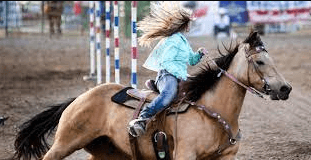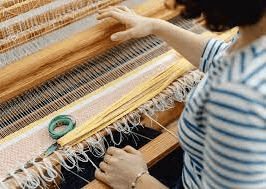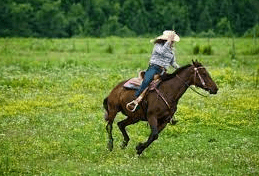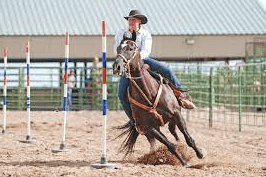Can Beginners Participate In Pole Bending Events, Or Is It Primarily A Sport For Experienced Riders?

Pole bending, a fast-paced equestrian event that requires precision and agility, has gained popularity among riders of all skill levels. While it is true that experienced riders often dominate the sport, beginners can certainly participate and excel in pole bending events with dedication and proper training.
This article aims to explore the world of pole bending for beginners, addressing the question of whether this sport is primarily reserved for experienced riders or if novices can also find success.
In order to understand whether beginners can participate in pole bending events, it is essential to grasp the basics of this exhilarating sport. Pole bending involves navigating a horse through a series of evenly spaced poles set in a straight line. The rider must weave their horse in and out of these poles as quickly as possible without knocking any over. It requires precise control over both speed and direction, making it an exciting challenge for both horse and rider alike.
While experience undoubtedly brings finesse and expertise to this sport, beginners can still participate by following proper training protocols, learning the rules and scoring system, building confidence gradually, and seeking resources and support tailored specifically to their needs as novice pole benders.
By understanding these aspects of pole bending, beginners can embark on an enriching journey towards mastery in this thrilling equestrian discipline.
The Basics of Pole Bending
The fundamentals of pole bending involve navigating a horse through a series of poles arranged in a straight line, requiring precise control and coordination from the rider. In order to participate in pole bending events, beginners will need basic riding skills and an understanding of how to communicate with their horse effectively.
The equipment needed for pole bending includes a well-fitted saddle, bridle, and protective gear such as helmets and boots. Common mistakes made by beginners include improper positioning and timing when guiding the horse through the poles, resulting in knocked down poles or missed turns. However, with practice and guidance from experienced riders or trainers, beginners can learn the necessary techniques and improve their performance in pole bending events.
It is important for beginners to start with lower-level competitions that provide a supportive environment to gain confidence and experience before moving on to higher-level events. With dedication and perseverance, even inexperienced riders can participate in pole bending events successfully.
Equipment and Training for Beginners
This discussion will focus on the equipment and training necessary for beginners to participate in pole bending events.
Choosing the right horse is crucial, as they need to be agile, responsive, and able to maneuver quickly through the poles.
In terms of gear and equipment, riders should invest in a sturdy saddle with good grip, protective boots for both the horse and rider, and appropriate tack such as reins and a bridle.
Additionally, training techniques and exercises should focus on building the horse’s agility, speed, and responsiveness to cues from the rider.
Choosing the Right Horse
When considering participation in pole bending events, it is crucial to carefully select a suitable equine partner.
The choice of horse breed plays a significant role in determining the success of a beginner rider in this sport. Certain breeds, such as Quarter Horses and Arabians, are known for their agility and speed, which are essential qualities for navigating the poles with precision.
Additionally, evaluating the horse’s individual agility is paramount. A horse with good balance, coordination, and quick reflexes will be better equipped to handle the sharp turns and bursts of speed required in pole bending.
Ultimately, choosing the right horse can greatly enhance a beginner’s chances of achieving success and enjoyment in pole bending events.
Necessary Gear and Equipment
One important aspect to consider in pole bending is having the necessary gear and equipment.
Pole bending gear typically includes a few key items that are essential for both safety and performance.
First, riders should invest in a well-fitting helmet to protect their heads from potential falls or collisions with the poles.
Additionally, wearing appropriate riding boots with a small heel can provide better grip and stability while maneuvering through the course.
As for the horse, it is crucial to have a properly fitted saddle that allows the rider to maintain balance and control during quick turns and maneuvers.
Other necessary equipment includes reins, which allow for communication between rider and horse, as well as protective leg wraps or boots for the horse’s legs.
For beginners participating in pole bending events, it is recommended to also have some specific training equipment such as pole bending poles or cones that can be used for practicing at home.
These tools will assist beginners in becoming familiar with navigating through the poles and improving their speed and accuracy over time.
Overall, having the right gear and equipment is crucial not only for safety but also for achieving optimal performance in pole bending competitions.
Training Techniques and Exercises
To enhance their pole bending skills, riders can employ various training techniques and exercises that have been proven effective in improving speed, agility, and precision while maneuvering through the poles.
Training techniques such as interval training can be utilized to improve a horse’s speed by alternating between intense bursts of energy and periods of rest.
In addition, incorporating exercises that focus on lateral movement and quick changes in direction can help develop the horse’s agility, allowing them to navigate the poles with greater ease.
Other exercise variations that can be beneficial include serpentines, where the rider guides the horse through a series of curves resembling an ‘S’shape, or figure-eight patterns that require precise turns and changes in direction.
By consistently practicing these training techniques and exercises, beginners can gradually improve their pole bending abilities and become more competitive in events.
Understanding the Rules and Scoring
The understanding of the rules and scoring in pole bending events is crucial for both beginners and experienced riders alike.
Pole bending is a timed event where horse and rider navigate through a series of poles arranged in a straight line, with the goal of completing the course in the fastest time possible without knocking over any poles.
Each pole bending run consists of two rounds, and the rider’s time is recorded for each round separately.
Common mistakes that beginners often make include knocking over poles, missing turns, or going off course, which can result in penalties or disqualification.
To avoid these mistakes, it is important for riders to practice proper techniques such as maintaining control and balance while maneuvering their horses around each pole.
Additionally, riders should study and understand the specific rules and regulations set by the governing body of pole bending events to ensure fair competition and accurate scoring.
By familiarizing themselves with these rules and avoiding common mistakes, both beginners and experienced riders can have a successful experience in pole bending events.
Tips for Successful Pole Bending
Surprisingly, mastering the art of pole bending requires more than just speed and agility. Training techniques play a crucial role in achieving success in this sport.
Beginners should focus on developing a strong foundation by practicing proper body positioning, balance, and coordination. They should start with slower speeds and gradually increase their pace as they become more comfortable.
It is important to practice both straight-line approaches and tight turns around the poles to improve maneuverability. Additionally, beginners should be aware of common mistakes such as knocking down poles or missing cues from their horse.
Regular practice sessions can help identify these errors and allow riders to work on improving their technique.
Overall, with dedication and consistent training, beginners can participate in pole bending events and gradually progress towards becoming skilled competitors.
Building Confidence as a Beginner
Building confidence as a beginner in pole bending requires setting realistic goals, overcoming challenges and fears, and celebrating progress and achievements.
Setting realistic goals is important as it allows beginners to break down their learning process into manageable steps, ensuring a sense of accomplishment along the way.
Overcoming challenges and fears is essential for building confidence, as it helps beginners push past their comfort zones and develop new skills.
Lastly, celebrating progress and achievements provides positive reinforcement, motivating beginners to continue their journey and strive for further improvement in pole bending.
Setting Realistic Goals
Developing realistic goals is crucial for beginners who wish to participate in pole bending events, as it allows them to chart their progress, assess their abilities, and work towards improvement effectively.
Setting realistic goals provides a clear direction and focus for beginners, helping them stay motivated and committed to their training. It also helps them overcome obstacles that may arise during the learning process.
By breaking down the skills required for pole bending into smaller achievable goals, beginners can track their progress and celebrate each milestone they achieve. This approach not only boosts confidence but also ensures that beginners do not become overwhelmed or discouraged by setting unattainable expectations.
Additionally, realistic goal setting enables beginners to identify areas where they need more practice or instruction, allowing them to seek guidance and improve their skills efficiently.
Overall, setting realistic goals is essential for beginners in pole bending as it provides structure, motivation, and a roadmap for continuous growth and success in this exhilarating sport.
Overcoming Challenges and Fears
Conquering challenges and facing fears head-on is a crucial aspect of excelling in the exhilarating world of pole bending.
In order to participate in this sport, beginners must overcome their fears and build confidence in their riding abilities. Pole bending requires riders to navigate through a series of poles set up in a zigzag pattern, often at high speeds. This can be intimidating for beginners who may have limited experience or are unfamiliar with the sport.
However, with proper training and dedication, beginners can gradually overcome their fears and develop the necessary skills to excel in pole bending events. By gradually increasing the difficulty level and practicing regularly, riders can gain confidence in their ability to maneuver their horse through the course without hesitation or fear.
Additionally, working with experienced trainers who provide guidance and support can greatly aid beginners in overcoming challenges and building confidence. With time and perseverance, even novice riders can become skilled competitors in pole bending events.
Celebrating Progress and Achievements
One interesting statistic to engage the audience is that pole bending competitors have demonstrated consistent improvement in their performance over time.
As beginners participate in pole bending events, they face various challenges and obstacles that may hinder their progress initially. However, through dedication and perseverance, riders gradually overcome these hurdles and celebrate important milestones along the way. By recognizing their own improvement, beginners gain a sense of accomplishment and motivation to continue working towards their goals.
Throughout the journey, riders learn to navigate the poles with greater speed and agility, honing their skills with each practice session and competition. This progression not only showcases the determination of beginners but also highlights the potential for growth within this sport.
Celebrating these milestones serves as a reminder of how far riders have come and encourages them to keep pushing themselves towards even greater achievements in pole bending events.
Competing as a Beginner
Participating as a novice in pole bending events is a viable option for beginners, as it allows them to build a strong foundation and develop their skills in the sport.
Pole bending is not exclusively reserved for experienced riders, but rather provides an opportunity for beginners to learn and grow.
By participating in these events, beginners can gain valuable experience and improve their technique over time.
Additionally, pole bending events often foster a supportive community where participants can connect with fellow riders who share similar interests.
This sense of community can provide encouragement and guidance as beginners navigate the challenges of learning a new sport.
Overall, competing as a beginner in pole bending events presents an avenue for individuals to develop their skills while finding support within the equestrian community.
Benefits of Pole Bending for Beginners
What are the advantages of pole bending for those who are new to the sport?
Pole bending for beginners offers several benefits that can help build skills and boost confidence.
Firstly, participating in pole bending events allows beginners to develop their riding abilities and improve their coordination. The quick turns and precise maneuvers required in pole bending require riders to have a strong connection with their horse and enhance their overall horsemanship skills.
Additionally, engaging in this sport helps beginners gain confidence as they successfully navigate through the poles at increasing speeds. As they practice and improve, their self-assurance grows, which can have positive effects on other areas of their equestrian journey.
Moreover, pole bending provides a sense of accomplishment as beginners progressively achieve faster times or better performances during competitions, fostering a rewarding experience that encourages further growth and development.
Overall, pole bending serves as an excellent platform for newcomers to build fundamental skills while gaining confidence in their riding abilities, making it an ideal choice for those starting out in the sport of rodeo or horseback riding.
Resources and Support for Beginner Pole Benders
A wealth of resources and support systems are available to assist novice pole benders in their journey towards mastery.
These resources include beginner pole bending classes that provide structured instruction and guidance for beginners to learn the basic techniques and skills required for pole bending events. These classes often have experienced instructors who can offer personalized feedback and advice to help beginners improve their performance.
Additionally, finding a supportive community is crucial for beginners as it provides encouragement, motivation, and opportunities for collaboration with other like-minded individuals. Joining local riding clubs or online communities dedicated to pole bending can introduce beginners to a network of experienced riders who can offer mentorship, share tips and tricks, and create a sense of camaraderie among fellow enthusiasts.
Overall, these resources and support systems ensure that beginners have access to the necessary tools and guidance needed to excel in the sport of pole bending.
The Journey of a Beginner Pole Bender
Embarking on the journey of learning pole bending can be a transformative experience for those entering the world of equestrian agility, as they navigate through the initial stages of skill development and immerse themselves in the challenges and triumphs that lie ahead.
Pole bending is not exclusively reserved for experienced riders; beginners can certainly participate in pole bending events. In fact, it is an excellent sport for beginners to develop their riding skills and gain confidence in their abilities.
Through regular practice, individuals can build strength and improve coordination as they learn to guide their horse through the intricate patterns of poles. The physical demands of pole bending require riders to have a strong core and lower body strength to maintain balance while maneuvering around each pole with precision. Additionally, it requires coordinated movements between rider and horse, as well as quick decision-making skills.
As beginners progress in their training, they will witness significant improvements in their physical fitness, riding technique, and overall horsemanship skills. By continuously challenging themselves and setting achievable goals, beginners can enjoy a fulfilling journey towards becoming skilled pole benders.
Frequently Asked Questions
How long does it take to become proficient in pole bending as a beginner?
Becoming proficient in pole bending as a beginner can take time and practice. However, the benefits for beginners include improved balance, coordination, and agility. Efficient training tips involve gradually increasing speed, focusing on technique, and utilizing proper equipment.
Are there any age restrictions for beginners participating in pole bending events?
Age restrictions for beginners participating in pole bending events vary depending on the specific event or organization. Some beginner-friendly events may allow participants of all ages, while others may have age limitations to ensure the safety and suitability of the activity.
Can beginners use any type of horse for pole bending events, or are there specific requirements?
Different horse breeds can be used for pole bending events, but using a trained horse has advantages for beginners. Trained horses are more responsive and have the necessary skills to navigate the poles effectively, increasing the chances of success for beginners.
Are there any specific safety precautions or equipment recommendations for beginner pole benders?
When it comes to beginner pole bending techniques, safety precautions and proper equipment are essential. Common injuries in pole bending for beginners include falls and collisions with the poles. Therefore, wearing a helmet and using protective leg wraps are recommended for novice riders.
What are some common mistakes beginners make in pole bending events and how can they be avoided?
Common mistakes beginners make in pole bending events include improper body positioning, lack of balance, and failure to anticipate the next pole. To avoid these mistakes, riders should focus on maintaining proper form, practicing balance exercises, and visualizing their path through the course. Additionally, it is crucial for beginners to prioritize a thorough warm-up and stretching routine before competing in pole bending events to prevent injuries and improve performance. By following these tips and dedicating time to enhancing their skills, beginners can gradually excel in this sport.
Conclusion
In conclusion, pole bending is a sport that can be enjoyed by both beginners and experienced riders. While it may seem daunting at first, with the right equipment, training, and understanding of the rules and scoring, beginners can successfully participate in pole bending events.
Building confidence as a beginner is key, and taking the time to practice and develop your skills will greatly contribute to your success in this sport. Competing as a beginner in pole bending can be an exciting and fulfilling experience. It allows you to showcase your progress and growth as a rider while challenging yourself to improve even further.
The benefits of pole bending for beginners are numerous – it helps develop agility, coordination, and communication between horse and rider. Additionally, participating in pole bending events provides an opportunity for beginners to connect with other riders who share their passion for the sport.
One interesting statistic related to pole bending is that the fastest recorded time for completing a set of poles is 19.4 seconds. This incredibly fast time showcases the skill and precision required for this sport. Imagine galloping down the line of poles with lightning speed, smoothly weaving through them without knocking any over – it truly highlights the athleticism of both horse and rider.
Overall, whether you are just starting out or have been riding for years, pole bending offers an exciting challenge that can be enjoyed by all levels of riders. With dedication, practice, and support from resources within the equestrian community, beginners can confidently participate in pole bending events and embark on their journey towards becoming skilled pole benders themselves.


